Dear foreign seniors, do you know that, in the Maguindanao province of the Philippines, there is a breakfast meal wrapped in banana leaves? Allow Tita S to tell you about it.
1.Pastil, or pastel, is a popular Filipino packed-rice dish made with steamed rice wrapped in banana leaves, with dry shredded beef, chicken or fish, originally from the Maguindanao1 province2, in the Bangsamoro Autonomous Region in Muslim Mindanao (BARMM)3, Philippines.
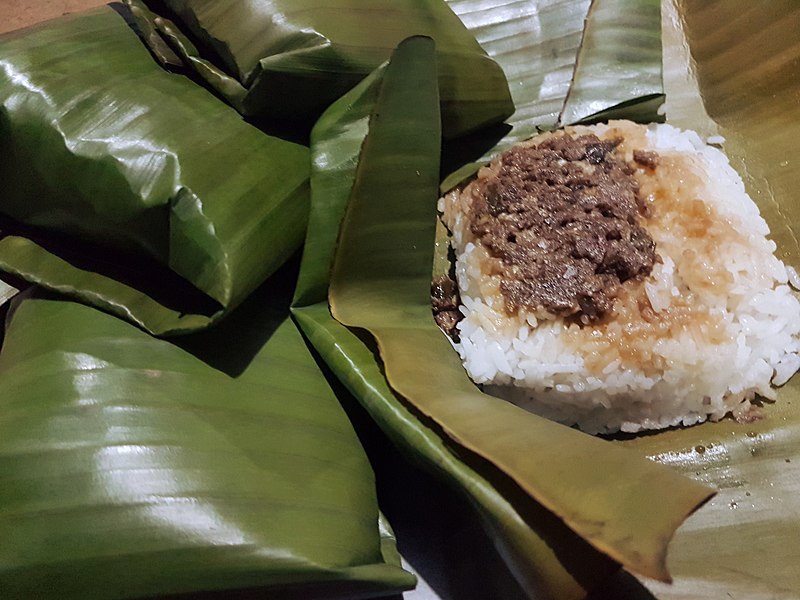
Photo source: Obsidian soul, own work, CC0, created 20 August 2019, https://en.wikipedia.org/wiki/Pastil#/media/File:Pastil_(Philippines)_01.jpg
2. The shredded meat or fish component of this dish is called kagikit. The (beef or chicken) meat is cooked like adobo4. It is first boiled until tender, allowed to cool, shredded into thin strips, sauteed in garlic and onions with soy sauce (or oyster sauce), black pepper, siling labuyo5, and salt to taste, and allowed to simmer until the liquid evaporates.
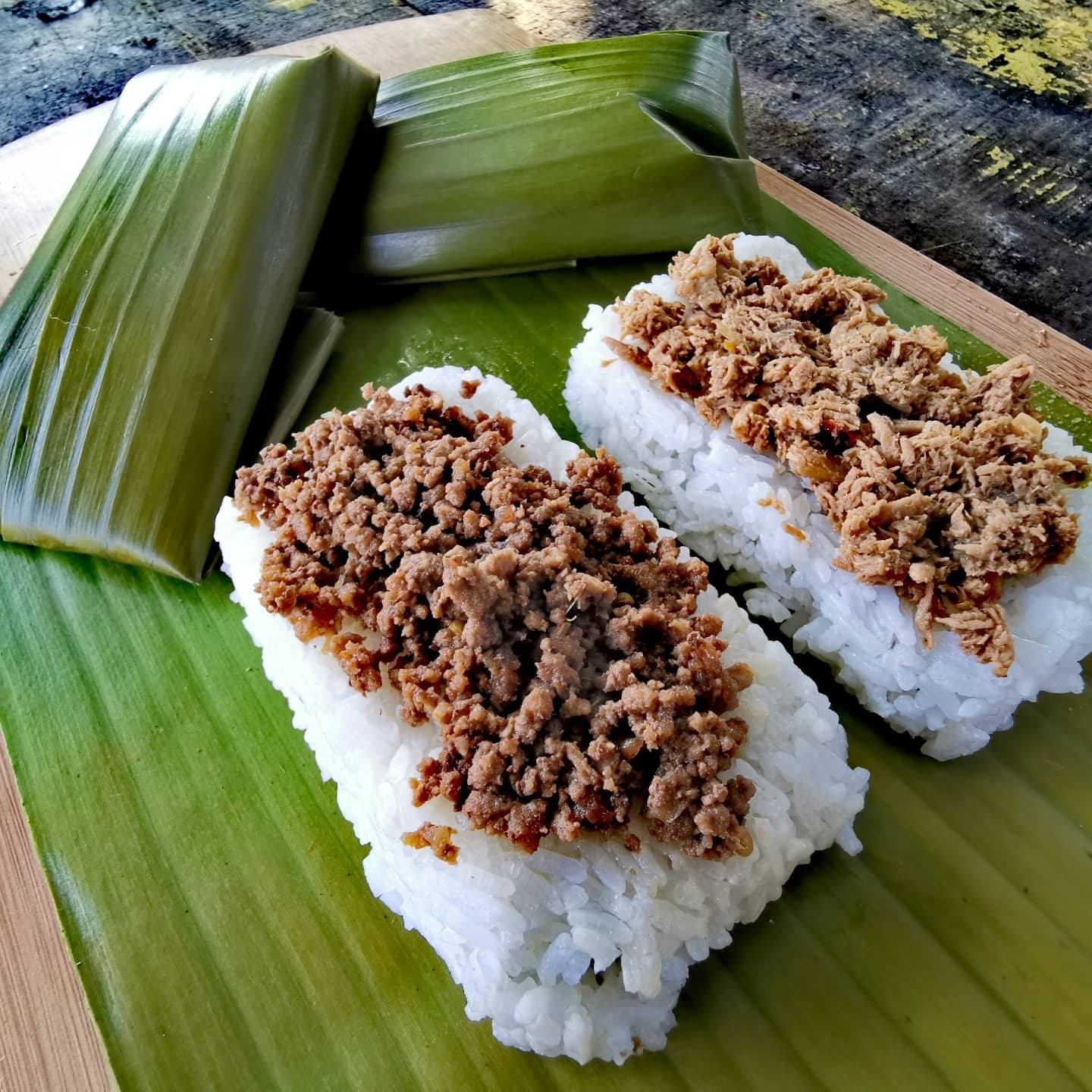
Photo source: https://www.facebook.com/pastilking/photos/a.119725359478756/138352220949403/
Walking catfish (katipa) or common snakehead (dalag) are the common fishes used. The fish is first grilled, then shredded.
3. The white rice is mixed with a small amount of glutinous rice, and steamed to maintain its shape.
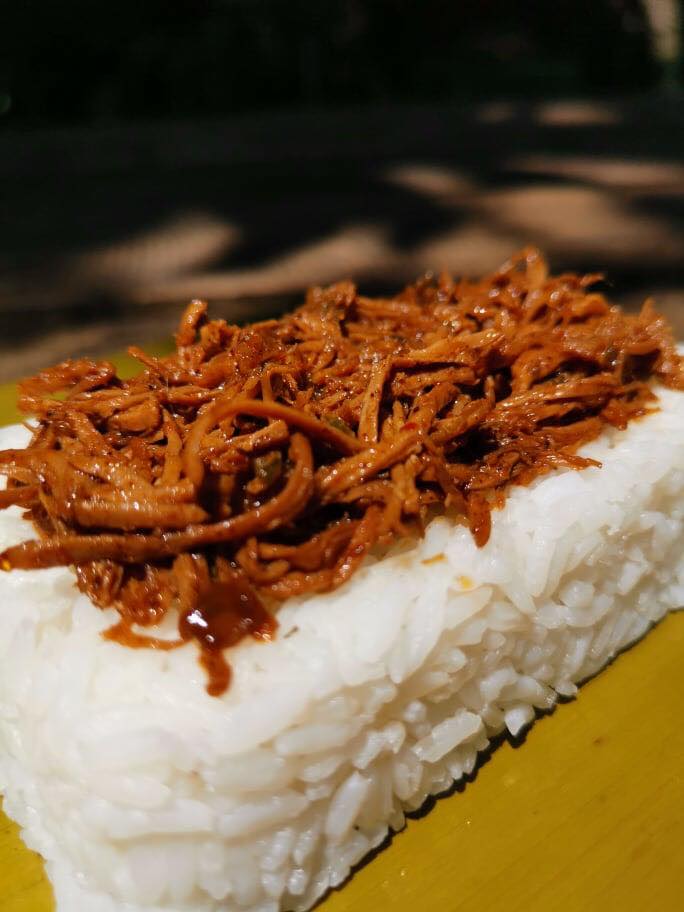
Photo source: https://www.facebook.com/pastilking/photos/537422317709056
If you add pandan6 leaves during steaming, the resulting rice will be so fragrant.
4. The banana leaves are first wilted over an open flame to make them pliable.
Oil is then brushed on the inside surface of the leaves.
5. The cooked steamed rice is placed on the prepared banana leaves, with the cooked and shredded meat or fish covering one side of the rice, or spread lengthwise along the portioned rice.
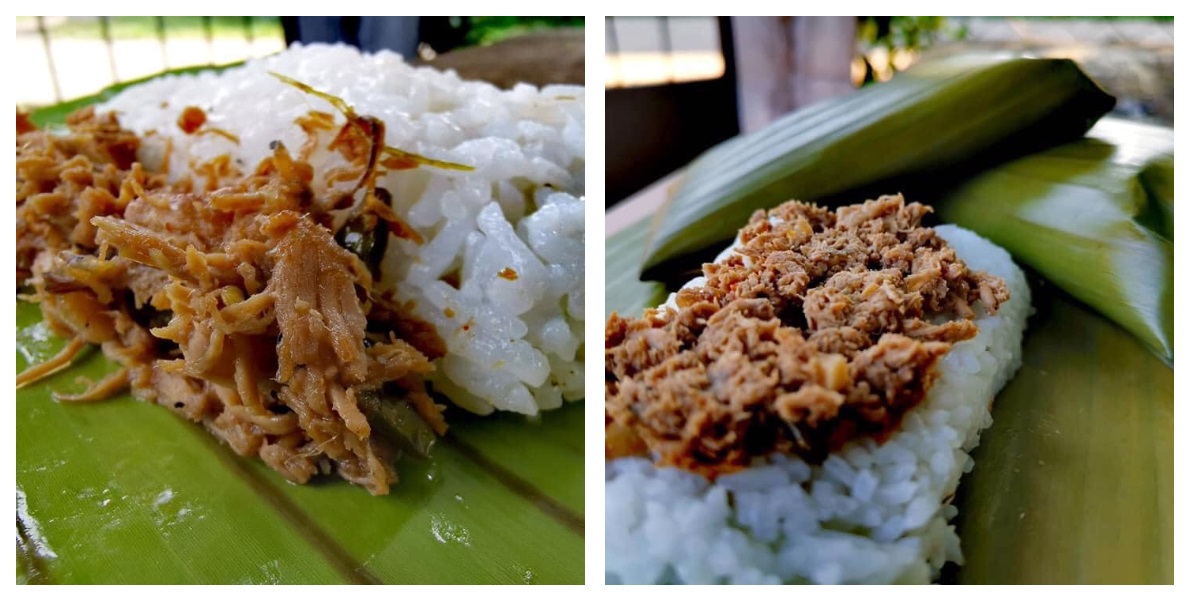
Source of photos: https://www.facebook.com/pastilking/photos/
6. The leaf is then wrapped to be shaped like a thick cylinder, with the ends tucked and folded backwards to keep the contents intact.
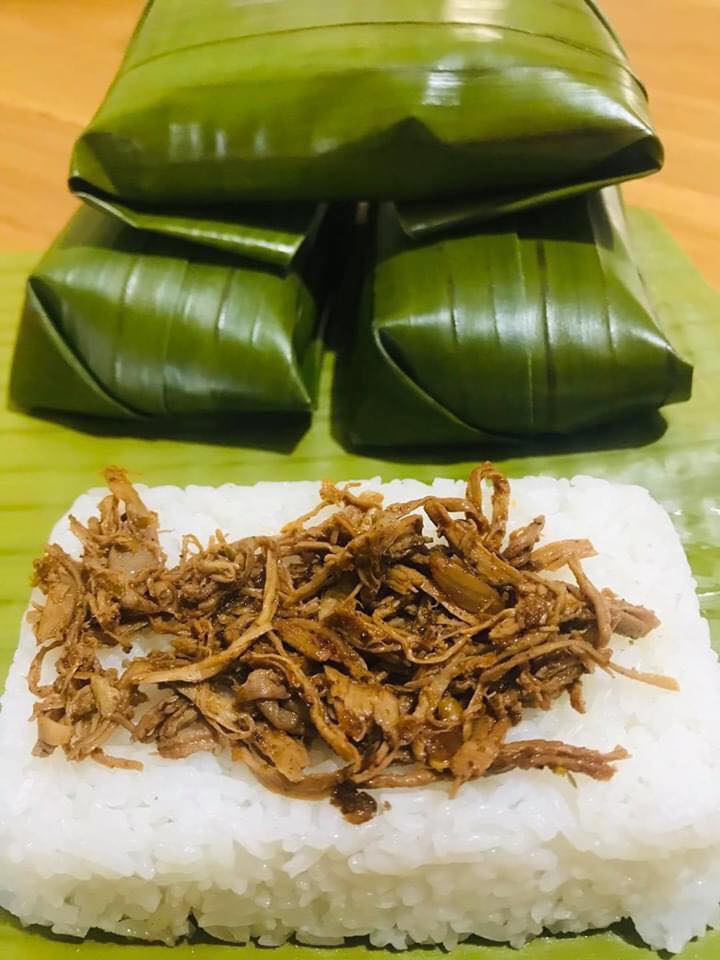
Photo source: https://www.facebook.com/pastilking/photos/534229308028357
For me, the wilted banana leaves impart a fragrant and appetizing aroma to the wrapped contents.
7. Pastil is traditionally served with vegetables soaked in vinegar as a side dish, like cucumber (pipino) or mung bean sprouts (togue), to neutralize the saltiness of the kagikit. A hard-boiled egg may be included to complement this meal.
8. It is usually eaten with coffee or hot chocolate (sikulate) for breakfast or as a snack.
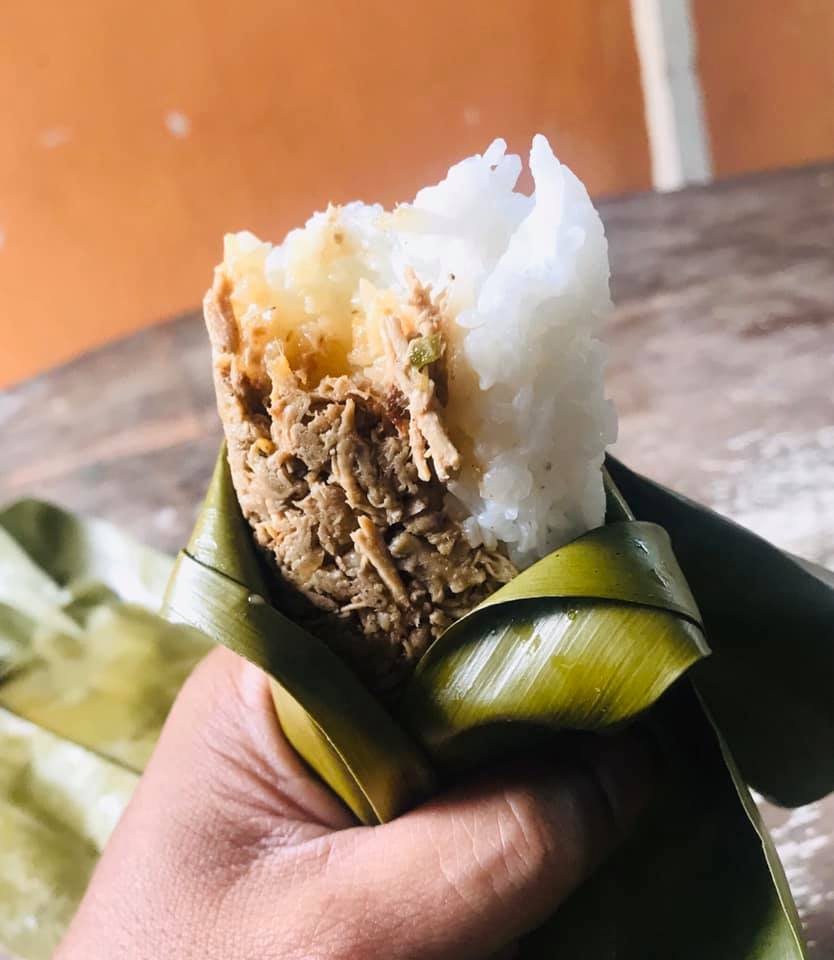
Photo source: https://www.facebook.com/pastilking/photos/140688007382491
9. It is commonly sold by restaurants and street vendors in Muslim communities in Mindanao7, and even other parts of the country.
It could also be served unwrapped, in rice bowls.
10. It is considered a cheap breakfast meal in Mindanao7, especially among Muslim Filipinos.
11. It is called patel. patil, pater, or patir in Maranao8, and paster in Iranun9.
12. It is similar to the northern Filipino binalot, a packed-rice dish using regular meat or fish dishes; the viand is not shredded.
See my post on binalot: BINALOT, BURP!
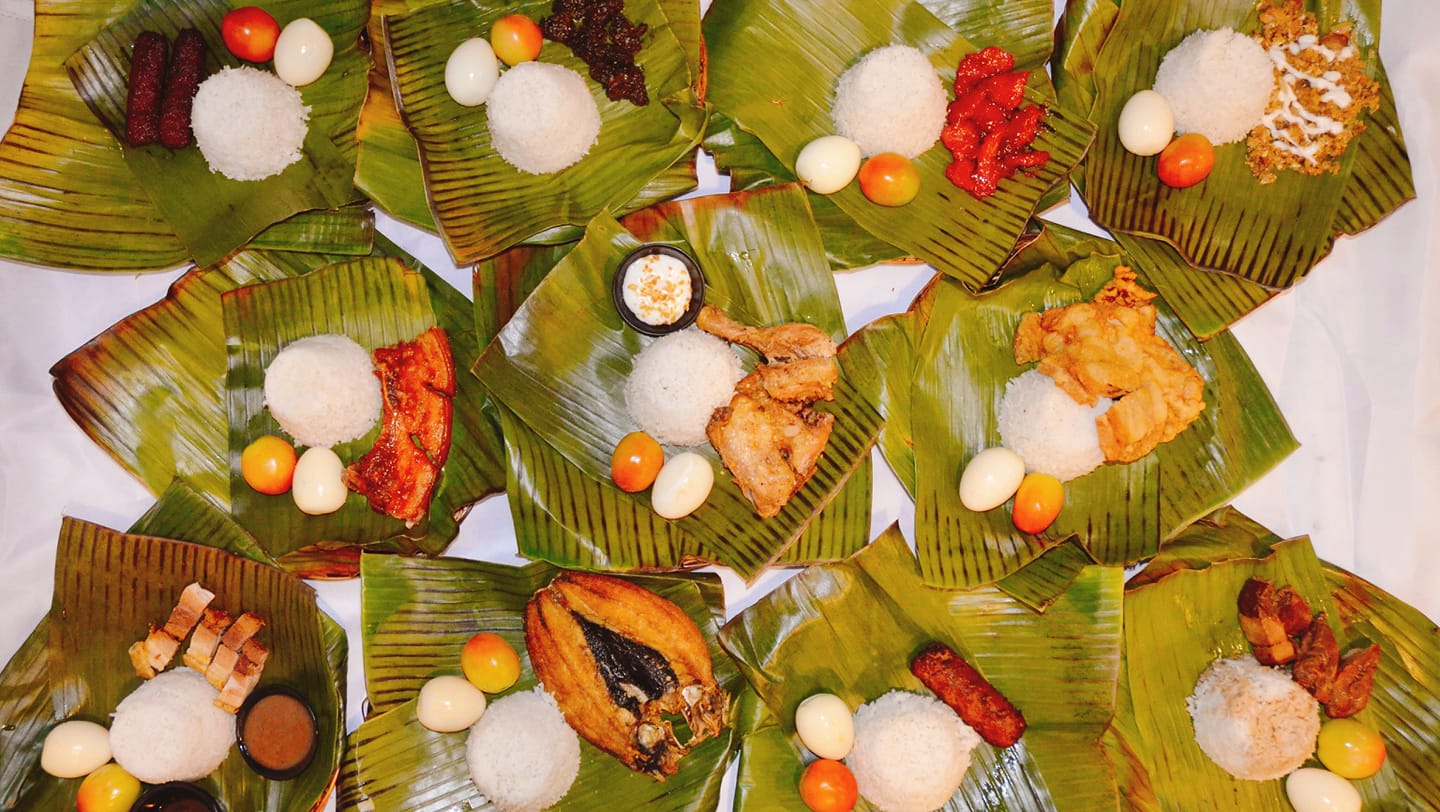
assorted binalot – Photo source – https://www.facebook.com/104993971329499/photos/a.104998407995722/104998391329057
13. Just so you know, pastil is also the Tausug10 name for a type of empanada, an unrelated pastry made with beansprout and glass noodle fillings.
The information was obtained from the Wikipedia page “Pastil”11
The photos featured in the cover picture-collage were obtained from https://www.facebook.com/pastilking/photos/140688007382491 (top) and https://www.facebook.com/pastilking/photos/216430193141605 (bottom).
This is not a sponsored post. I just want my readers to know more about Philippine delicacies.
Did you find this post informative? Would you like to try making this treat at home? I would like to hear your comment/s regarding pastil.
See other interesting posts in this category (Pinoy Delights) and other categories – SCapades and Smart Travelers – Foreign Travelers Ask, Now You Know, and Say, Say, Say. Happy reading, and I hope that you will appreciate what I shared and some of the featured destinations will be part of your future travel plans!
Remember to share this post with your Facebook friends, follow me by clicking on the bottom right corner of your device, and do not forget to like this post. Thank you.
– – – – – – – – – – – – – – – – – – – – – – – – – –
The following terms are defined for interested readers, especially those with “Senior-Moments”, those not familiar with Filipino terms, and those too busy or lazy to Google such terms:
1Maguindanao is a province2 located in the Bangsamoro Autonomous Region in Muslim Mindanao (BARMM)3, in the Philippines. It is bordered by the provinces of Lanao del Sur on the north, Cotabato to the east, Sultan Kudarat to the south, and the Illana Bay to the west. The information was obtained from the Wikipedia page “Maguindanao”.12
Historically, the Maguindanao are known as metalworkers, producing (circular metallic percussion instrument), the wavy-bladed kris (dagger) and other weapons.13
2A province is the primary administrative and political division in the Philippines. It is the second-level administrative sub-division of a region14. There are 81 provinces (called lalawigan) in the Philippines. Each province is governed by an elected legislature called the Sangguniang Panlalawigan, and by an elected governor. Remember, a province in the Philippines is divided into cities and towns (called municipalities15), which in turn, are divided into barangays16, formerly called barrios. The information was obtained from Wikipedia page “Provinces of the Philippines.”17
See a related post: Foreign Seniors Ask: WHAT ARE PROVINCES IN THE PHILIPPINES?
3Bangsamoro Autonomous Region in Muslim Mindanao (BARMM), or Bangsamoro, is an autonomous region14 located in southern Philippines. It replaced the Autonomous Region in Muslim Mindanao (ARMM) after the creation of the Bangsamoro Organic Law, signed by President Rodrigo Duterte on July 26, 2018. It is currently in transition until 2022.
Bangsamoro literally means “Moro nation” or “Moro country”. This region consists of 5 provinces2 (Basilan except Isabela City, Lanao del Sur, Maguindanao1, Sulu and Tawi-Tawi), 116 towns (called municipalities) and 3 component cities (Cotabato City, Lamitan and Marawi).
The information was obtained from the Wikipedia page “Bangsamoro”.18
4Adobo is a Filipino version of the Spanish adobo/adobar, according to Wikipedia page “Adobo”.19 It was originally made by stewing meat (chicken and/or pork) in vinegar and soy sauce, with garlic, salt and bay leaves, sometimes with sliced potatoes. The meat is sometimes fried after stewing.
5Siling labuyo, or simply labuyo, is a small chili pepper that developed in the Philippines after the Columbian Exchange20. It belongs to the species Capsicum frutescens and is characterized by triangular, very pungent fruits which grow pointing upwards. Siling labuyo is a Tagalog term meaning “wild chili”.
It is a very small hot pepper, measuring 0.20 in (0.51 cm) in length and 0.10 in (0.25 cm) in width, clustered in groups of 2 to 3 at a node. Immature fruits are deep green in color but turns to a vivid red when ripe. At one time, the Guinness Book of World Records listed it as the hottest chili in the world but other hotter varieties have since been identified. It measures around 80,000-100,000 Scoville units, which is at the lower end of the range for the hotter habanero chili (rated 100,000-350,000 Scoville units and a popular ingredient in hot sauces).
Its fruits and leaves are used in traditional Philippine cuisine. The fruit is popularly used to flavor vinegar to be used as a spicy condiment or dip, while the leaves are consumed as a vegetable, like in the Philippine chicken soup dish called tinola.
See a related post: TEMPTING AND TASTY TINOLA
The information was obtained from the Wikipedia page “Siling labuyo”.21
6Pandanus amaryllifolius is a tropical plant in the Pandanus (screwpine) genus, which is commonly known as pandan. Its fragrant leaves are tied into a knot and boiled to extract the green juice used as coloring and flavoring to native South and Southeast Asian cuisine. It also gives a pleasant aroma to boiled rice and other dishes. The information was obtained from the Wikipedia page “Pandanus amaryllifolius”.22
7Mindanao is one of the 3 major geographical divisions of the Philippines. It is the second largest island of the country and covers 6 administrative regions14: Caraga, Davao, Northern Mindanao, SOCCSKSARGEN, Zamboanga Peninsula, and the Bangsamoro Autonomous Region in Muslim Mindanao (BARMM)3. It is composed of 22 provinces2 and 33 cities (27 provinces and 33 cities, if associated islands are included). The information was obtained from Wikipedia page “Mindanao.”23 Mindanao is located in the southern part of the country; the 2 other geographical divisions of the Philippines are Luzon (in the northern part) and Visayas (the middle part).
8Maranao is an Austronesian language spoken by the Maranao24 people in the provinces2 of Lanao del Norte and Lanao del Sur, in northwestern Maguindanao1, northwestern Cotabato, and northwestern Bukidnon, all located in the Mindanao7 group of islands in southern Philippines. It is also a language in the state of Sabah, Malaysia. It is spoken with a distinct downstep25 accent, aspired “hard consonants”, which also raise the quality of following vowels. The information was obtained from Wikipedia page “Maranao language.”26
9The Iranun language is spoken by the Iranun people who are a Moro ethnic group native to Mindanao7, Philippines. It is also a language spoken in the west coast of Sabah, Malaysia. The Iranun and Maranao24 still speak the language closest to the ancient Proto-Danaw among all of the Danao languages spoken by these groups.
The Iranun people are believed to be descendants of Maranao who left Lake Lanao, and settled elsewhere. These migrations were usually merchant clans of the Maranao who established trading routes near the coast.
The information was obtained from Wikipedia page “Iranun people.”27
10The Tausug people, or Suluk, are an ethnic group of the Philippines and Malaysia, and even a small population in the northern part of North Kalimantan, a province in Indonesia. You have to understand that the Tausugs originally had an independent state known as the Sultanate of Sulu, which once exercised sovereignty over the present day provinces of Basilan, Palawan, Sulu, Tawi-Tawi, Zamboanga City, the eastern part of the Malaysian state of Sabah (formerly North Borneo), and North Kalimantan, Indonesia.
The Tausugs are part of the wider political identity of Muslims of Mindanao, Sulu and Palawan. Most have converted into the religion of Islam and it members are now known as the Moro28 group, who constitute the 3rd largest ethnic group of Mindanao7, Sulu and Palawan.
The word Tausug is derived from two words: tau (“person”) and Sug (“Sulu”). so Tausug means “people of Sulu”. The local name of their language is bahasa Sug (Sulu language).
The Tausug language is the language spoken by the Tausug people. It is related to Bicolano, Tagalog and Visayan languages, being closely related to the Surigaonon language of the provinces of Surigao del Norte, Surigao del Sur and Agusan del Sur, as well as the Butuanon language of northeastern Mindanao, sharing common words with Tausug which were not influenced of the Arabic language.
The information was obtained from Wikipedia page “Tausug people.”29
11“Pastil” accessed December 19, 2019, https://en.wikipedia.org/wiki/Pastil
12“Maguindanao” accessed April 2, 2018, https://en.wikipedia.org/wiki/Maguindanao
13https://www.britannica.com/topic/Maguindanao-people
14A region is an administrative division based on geographical, cultural and ethnological characteristics. Each region is further subdivided in provinces2, composed of cities and municipalities15 (or towns), which in turn, are divided into barangays15, formerly called barrios, according to Wikipedia page “Regions of the Philippines” 30.
See a related post: Foreign Seniors Ask: WHAT ARE THE REGIONS OF THE PHILIPPINES?
15A municipality is a small, single urban administrative division, or local government unit (LGU)31, in the Philippines which has corporate status and powers of self-government or jurisdiction as granted by law. It is a unit under a province2, subdivided into barangays16, and is called town, or bayan. In the Philippines, a municipality is headed by a mayor, a vice mayor and members of the Sangguniang Bayan (legislative branch). The information was obtained from Wikipedia page “Municipalities of the Philippines.”32
16A barangay in the Philippines is the smallest administrative division in the Philippines, headed by a barangay captain, aided by a Sangguniang Barangay (Barangay Council). It is the native Filipino term for a village. It was formerly called a barrio. In a metropolitan area, a barangay is an inner city neighborhood, a suburb, or a suburban neighborhood. The word barangay originated from the term balangay, a kind of boat used by a group of Austronesian people who migrated to the Philippines. A number of barangays grouped together is called a district. The information was obtained from Wikipedia page “Barangay.”33
17“Provinces of the Philippines,” accessed May 29, 2019, https://en.wikipedia.org/wiki/Provinces_of_the-Philippines
18“Bangasamoro,” accessed April 2, 2018, https://en.wikipedia.org/wiki/Bangsamoro
19“Adobo,” accessed December 12, 2018, https://en.m.wikipedia.org/wiki/Adobo
20The Columbian Exchange, or the Columbian Interchange, was the widespread transfer of plants, animals, culture, (free and enslaved) human populations, technology, diseases, and ideas between the Americas and the Old World in the 15th and 16th centuries. It is named after Christopher Columbus, and is related to European colonization and trade following his 1492 voyage. This term was first used in 1972 by the American historian Alfred W. Crosby in his environmental history book “The Columbian Exchange”. It was rapidly adopted by other historians and journalists. The information was obtained from Wikipedia page “Columbian Exchange”.34
21“Siling labuyo” accessed December 19, 2019, https://en.wikipedia.org/wiki/Siling_labuyo
22“Pandanus amaryllifolius,” accessed March 29, 2019, https://en.wikipedia.org/wiki/Pandanus_amaryllifolius
23“Mindanao,” accessed April 2, 2018, https://en.wikipedia.org/wiki/Mindanao
24The Maranao people are the southern indigenous people who are the “people of the lake”, predominantly-Muslim Lanao, in the Mindanao group of islands, Philippines. They are known for their artwork, weaving, wood, plastic and metal crafts, and Daragen, their epic literature which is a UNESCO Intangible Cultural Heritage.
The name “Maranao” means “people of the lake”, in reference to Lake Lanao, the ancestral homeland of the Maranao people.
They are ethnically and culturally closely related to the Iranun27 and Maguindanao, with all 3 groups denoted as speaking Danao languages and giving name to the island of Mindanao.
The information was obtained from Wikipedia page “Maranao people”.35
25Downstep is a phenomenon in languages where when 2 syllables have the same tone, the 2nd syllable is lower in pitch than the first.36
26“Maranao language” accessed December 19, 2019, https://en.wikipedia.org/wiki/Maranao_language
27 “Iranun people” accessed December 19, 2019, https://en.wikipedia.org/wiki/Iranun_people
28The collective term Moro people, or Bangsamoro people, refers to the 13 Islamized ethnolinguistic groups of Mindanao, Sulu, and Palawan, native to the region known as the Bangsamoro3 (lit. “Moro nation” or “Moro country”). As Muslim-majority ethnic groups, they form the largest non-Christian population in the Philippines, and comprise about 5% of the country’s population, or 5 million people.
Outside the Philippines, some Moros remain in areas once controlled by the Sulu Sultanate along the eastern coast of Sabah, Malaysia; others emigrated to Malaysia, Indonesia and Brunei in the late 20th century due to the Moro conflict in Mindanao. New communities can be found today in Kota Kinabalu, Sandakan, and Semporna in Sabah, Malaysia, North Kalimantan in Indonesia, and in Bandar Seri Begawan in Brunei.
The information was obtained from Wikipedia page “Moro people”.37
29“Tausug people” accessed December 19, 2019, https://en.wikipedia.org/wiki/Tausug_people
30“Regions of the Philippines,” accessed July 17, 2018, https://en.wikipedia.org/wiki/Regions_of_the_Philippines
31A local government unit (LGU) in the Philippines is divided into 3 levels: provinces2 and independent cities38; component cities39 and municipalities15; and, barangays16, according to Wikipedia page “Local government in the Philippines”.40
32“Municipalities of the Philippines” accessed April 2, 2018, https://en.wikipedia.org/wiki/Municipalities_of_the_Philippines
33“Barangay,” accessed December 30, 2018, https://en.m.wikipedia.org/wiki/Barangay
34“Columbian exchange” accessed December 19, 2019, https://en.wikipedia.org/wiki/Columbian_exchange
35“Manarao people” accessed December 19, 2019, https://en.wikipedia.org/wiki/Maranao_people
36https://findwords.info/term/downstep
37“Moro people” accessed December 19, 2019, https://en.wikipedia.org/wiki/Moro_people
38An independent city in the Philippines is no longer subject to review by any province’s Provincial Board (Sangguniang Panlalawigan), stops sharing its tax revejue with any province, and is directly supervised by the President of the Philippines. There are currently 38 independent cities in the Philippines.
See a related post: Foreign Seniors Ask: HOW MANY CITIES ARE THERE IN THE PHILIPPINES?
There are 2 kinds of independent cities:
* Highly urbanized city (HUC) – This is a city with a minimum population of 200,000 inhabitants, as certified by the Philippine Statistics Authority, and with the latest annual income of at least PHP50 million or US$1 million, as certified by the City Treasurer. There are currently 33 such cities in the Philippines.
* Independent component city (ICC) – This is a city has a charter that explicitly prohibits its residents from voting for provincial officials. There are currently 5 such cities: Cotabato, Dagupan, Naga (Camarines Sur), Ormoc and Santiago.
The information was obtained from Wikipedia page “Cities of the Philippines”.41
39A component city (CC) is a type of city in the Philippines which does not meet the requirements of a highly urbanized city38. It is under the jurisdiction of a province2. If such a city is located along the boundaries of 2 or more provinces, it shall be considered part of the province of which it used to be a municipality15. The information was obtained from the Wikipedia page “Cities in the Philippines.”41
40“Local government in the Philippines,” accessed April 2, 2018, https://en.wikipedia.org/wiki/Local_government_in_the_Philippines
41“Cities in the Philippines,” accessed April 2, 2018,

